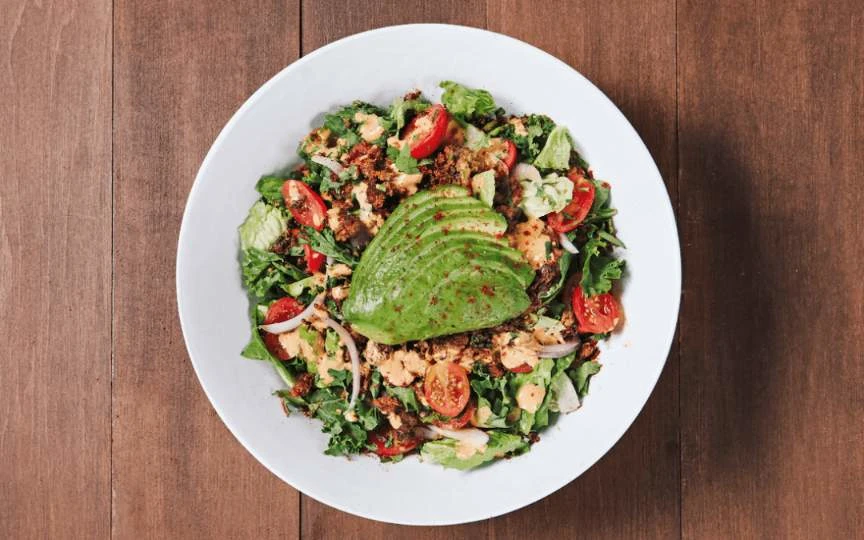(What if?)
3 Reasons Why Colleges & Universities Should Include Plant-Based Foods on their Menus

During their college search, students seek out universities that not only meet their academic standards, but also align with their personal values and preferences. As we all know, a major part of campus life is the dining experience, and they will want to see food options that fit their needs. As more Gen Z consumers choose to reduce their meat consumption and increase their demand for plant-based foods, it’s more important than ever for higher-education institutions to offer diverse, inclusive meals that appeal to a wide variety of students.
Plant-based foods have gone mainstream among Gen Z
In the U.S., Gen Z (those born in the mid to late '90s(opens in a new tab)) is leading the charge for a plant-based future. No longer relegated to hippies or Californians, plant-based food appeals to Gen Zers of all cultures and geographies:
55% of US Midwest university students have tried a plant-based meat alternative(opens in a new tab) and attributed this choice to the enjoyment of new food, curiosity about the products, and environmental concern.
51% of Black Gen Z consumers(opens in a new tab) have eaten a plant-based meat alternative in the past year, and between 35-41% of Gen Zers across financial situations agreed.
79% of Gen Zers said they would go meatless one or two times a week(opens in a new tab), according to research by Aramark, a foodservice provider to more than 400 colleges and universities.
And Gen Zers aren’t just idealists, they stand behind their beliefs — an Impossible Foods survey found that 62% of Gen Z respondents are willing to spend more money(opens in a new tab) on food products that don’t harm the environment. This generation has grown up seeing plant-based foods on menus and at shelves and are part of a growing ‘flexitarian’ movement of meat eaters that love eating plant-based options and are willing to pay more for sustainable options.
As a result, colleges and universities across the country(opens in a new tab) are being recognized for their efforts to satisfy this generation’s desire to eat more sustainably. That means colleges have a massive opportunity to cater to this generation’s preferences and offer meat alternatives.
Benefits of offering plant-based items on campus
Education Dive reported that more than 140 universities — including Tulane, Johns Hopkins and Columbia University — have “Meatless Monday” programs.(opens in a new tab) New York University, University of Pittsburgh, Harvard, and many others joined the Cool Food Pledge(opens in a new tab), an initiative to reduce greenhouse gas emissions associated with food by serving eco-friendly items. The University of North Texas opened Mean Greens(opens in a new tab), a 100% vegan dining hall, back in 2011.
So many colleges across the U.S. have joined the plant-based movement, and for good reason — as it provides a competitive advantage while benefiting students and the planet.

Impossible™ Tacos from Chica's Tacos, Image courtesy of LATaco.com(opens in a new tab)
1. Attract a wide variety of students with inclusive menus
Offering plant-based menu items ensures that students of all cultural and ethnic backgrounds, dietary needs, tastes, and value systems feel comfortable and excited about their campus food selection. Instead of being limited to the salad bar, vegetarians will rejoice in having a variety of options to choose from.
Meanwhile, omnivores and flexitarians will happily cut down their meat consumption by substituting tasty plant-based alternatives. And as more pro athletes tout the benefits of plant-based eating,(opens in a new tab) many student athletes are seeking similar diets to boost their performance on the field. In fact, food service management firm Chartwells Higher Education launched a 100% Plant-Forward dining program(opens in a new tab) to help universities explore new, plant-based meal options and their health benefits at universities nationwide.
Plant-based menus help to create an inclusive dining environment that aligns with Gen Z values and helps all students feel at home.
2. Boost on-campus dining sales
When students eat on campus, universities are able to build a strong community while boosting their bottom line. But a College & University survey found that nearly half of all college students eat off campus every day(opens in a new tab), with 28% of respondents saying they choose off-campus meals because of the delicious food, and 26% looking for a specific type of food.
The versatility of plant-based meats and foods allow universities to incorporate global flavors into their menus and offer a new take on classic dishes like meatballs, tacos, and burgers. By offering a wide selection of high-quality foods, including plant-based options, on campus, colleges have the opportunity to boost dining hall usage and sales. Since opening their vegan dining hall, the University of North Texas has seen a 10-15% annual increase in foot traffic, (opens in a new tab)and recently added more seating to meet growing demand. Another study at an English university found that doubling the proportion of vegetarian meals in its cafeterias resulted in sales increases between 41% and 79%.(opens in a new tab)
A study at an English university found that doubling the proportion of vegetarian meals in its cafeterias resulted in sales increases between 41% and 79%.

And universities don’t have to tackle plant-based menus alone — they can partner with popular quick-service restaurants (QSRs) who offer plant-based items,(opens in a new tab) such as Burger King, White Castle, and Johnny Rockets. Bringing these well-known restaurants to student unions and campus events keeps students on campus and even helps with recruiting.
3. Achieve your sustainability goals
Students today seek food that supports a healthy planet and builds a sustainable future, and plant-based foods provide a flavorful solution. In an Impossible Foods survey, 77% of Gen Z respondents said they care about environmental sustainability as a value.(opens in a new tab) Eating a plant-based diet could reduce food-related emissions by up to 73%, according to a University of Oxford study(opens in a new tab). By incorporating plant-based foods into dining halls, students can feel certain that their college shares their values.
Colleen Wright-Riva, director of dining services at University of Maryland, explained why they joined the Cool Food Pledge(opens in a new tab): “Students have told us they care about fighting climate change. Now, the food they eat — a huge part of their impact on the planet — can reflect these values and help achieve a more sustainable future.”
Plant-based menu items can be combined with other eco-conscious dining initiatives that reflect Gen Z values. For example, the Department of Agricultural Sciences at Morehead State University in Kentucky(opens in a new tab) operates an on-campus farm that sources local ingredients for its dining halls.
Get inspired by these plant-based menu items
If you’re ready to offer plant-based items but not sure where to start, Impossible Foods is here to help. We work with foodservice directors at colleges and universities to incorporate tasty and creative meals into their menus.
Research firm Datassential revealed the top five menu items offered at colleges and universities as follows:
Sausage
Sandwich
Fries
Burger
Salad
Three out of the five items (sausage, sandwich and burgers) are meat-forward dishes, while the remaining two can be dressed with meat (e.g., poutine or loaded fries, salad with meat add-ons). Keep reading to see how easily you can swap Impossible Foods products into these popular college dishes to transform them into plant-based delights.
1. Impossible™ Breakfast Sandwich

Jamba Juice Handwich, Source: Instagram(opens in a new tab)
Nothing caters to a college students’ weekend brunch craving like a sausage, egg, and cheese sandwich. Instead of a traditional pork sausage, use Impossible™ Sausage Made From Plants. Impossible™ Sausage(opens in a new tab) comes in pre-seasoned, pre-cooked patties that are easy to cook and perfect for breakfast — or any time of day. In a breakfast sandwich taste test with more than 200 consumers, the Impossible Sausage was preferred 54% to 46% over the leading pork sausage.
2. Impossible™ Patty Melt Sandwich
This fresh take on a classic patty melt features Impossible™ Burger, cheese, dill pickle slices, and caramelized onions. Add it in your sandwich rotation to switch things up at lunchtime, and pair it with some fun sides. Get the Impossible Patty Melt recipe(opens in a new tab).

3. Impossible™ Chili Cheese Fries
Impossible Chili Cheese Fries are perfect for late night cravings or a cozy afternoon. Between the juicy Impossible Burger meat, flavorful spices, fresh scallions, and sour cream topping, every bite of this shareable snack is heaven. Get the Impossible Chili Cheese Fries recipe(opens in a new tab).

4. Impossible Burger
There’s nothing more iconic than a good burger, but this one is anything but basic. In it, you’ll find Impossible Burger with some delightfully unlikely pairings, like sriracha and pepperoncini, along with classic ingredients like fresh sliced tomato, onions, and lettuce. Consider serving it on a brioche bun to add a hint of sweetness that pulls all of the flavors together. Get the Americana Impossible Burger recipe(opens in a new tab).

5. Impossible™ Taco Salad
Nothing beats the fresh, well-rounded flavor of this protein-packed salad. Made with sweet red onions, tangy cherry tomatoes, crunchy romaine lettuce, seared Impossible Burger, and crispy tortilla chips, it makes a meaty, satisfying lunch or dinner. Get the Impossible Taco Salad recipe(opens in a new tab).

Image courtesy of Mendocino Farms(opens in a new tab)
Appeal to today’s students with plant-based items
To keep up with the growing demand for plant-based foods, colleges and universities should create a versatile dining program that appeals to Gen Z’s values and preferences around sustainability, inclusivity, and health. Impossible Foods provides a simple way to incorporate plant-based meat into a variety of delicious meals.

